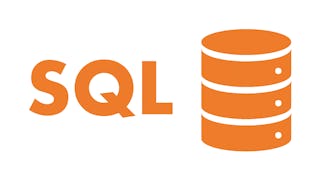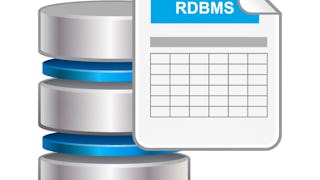Master the art of relational databases with this comprehensive course, designed to equip you with essential skills for database modeling, design, and implementation. You’ll start with core concepts like Entity-Relationship (ER) modeling, progressing through relational algebra and foundational SQL commands for creating, manipulating, and querying databases.

Économiser 160 dollars sur l'accès à plus de 10 000 programmes est un véritable plaisir pour les fêtes de fin d'année. Économisez maintenant.


Expérience recommandée
Ce que vous apprendrez
Design comprehensive database schemas using ER modeling and normalization, transform conceptual models into efficient relational structures.
Execute complex SQL operations for data manipulation and querying, master DDL and DML statements to manage database content effectively.
Implement transaction processing and concurrency control mechanisms, apply indexing and optimization techniques for high-performance systems.
Compétences que vous acquerrez
- Catégorie : Databases
- Catégorie : Database Architecture and Administration
- Catégorie : Data Modeling
- Catégorie : Logical Reasoning
- Catégorie : Query Languages
- Catégorie : Information Technology
- Catégorie : Relational Databases
- Catégorie : Database Design
- Catégorie : Transaction Processing
- Catégorie : SQL
- Catégorie : Data Analysis
- Catégorie : Data Integrity
- Catégorie : Problem Solving
- Catégorie : Data Storage
- Catégorie : Database Theory
- Catégorie : Data Management
- Catégorie : Information Architecture
- Catégorie : Database Management
- Catégorie : System Design and Implementation
- Catégorie : Database Systems
Détails à connaître

Ajouter à votre profil LinkedIn
novembre 2025
Découvrez comment les employés des entreprises prestigieuses maîtrisent des compétences recherchées

Il y a 10 modules dans ce cours
All Information Systems operate on data. Most of the systems depend on Database Management Systems, commonly referred as DBMS, to store the data and enable updates and retrievals. Modern DBMS have rich functionality to maintain and protect data during concurrent access from users. We look at expectations from DBMS to meet the needs of organizations. We will finally look at varieties of DBMS that are available.
Inclus
13 vidéos10 lectures5 devoirs
In this module, we discuss the basic concepts of conceptual database design. We understand anomalies in database operations. You will be introduced to the Entity–Relationship (ER) model, which is a popular high-level conceptual data model. We will discuss the diagrammatic notations used with the ER model, the ER model's constraints, and their use in the design of conceptual schemas for database applications. We also understand the basics of the Enhanced Entity–Relationship (EER) Model.
Inclus
13 vidéos13 lectures6 devoirs
In this module, we discuss the basic concepts of Relational Model. We understand the Relational Model Terminologies. We discuss the characteristics of Relations and the Relational constraints. We also learn and understand the update Operations and the ways to deal with Constraint Violations. We learn the steps and process of mapping ER Constructs to relations.
Inclus
17 vidéos17 lectures7 devoirs
In this module, we will learn formal query languages associated with the relational model. We will look at query operators in these languages and see how we can combine the operators to get the desired results.
Inclus
13 vidéos13 lectures6 devoirs
In this module, we will learn Structured Query Language(SQL), which is a standard-based language implemented by all relational databases to enable working with the structure and contents of the database . We will look at statements for defining schema, querying, and updating data in the database.
Inclus
17 vidéos17 lectures7 devoirs
In this module, we discuss the basic concepts of Functional dependencies and inference rules. We understand anomalies in database operations. We understand the need for normalization of relational schemas. We discuss the conditions for various Normal Forms- 2NF, 3NF, and BCNF. We explore the process of decomposition used to take a relation to higher normal forms. We learn how to check whether a decomposition is lossless or dependency-preserving.
Inclus
10 vidéos8 lectures5 devoirs
In this module, you will understand important disk properties and how data is stored on the disk. You learn about the File storage schemes for storing data. You learn important static hashing and dynamic hashing schemes used for storing and fast retrieval of data from the database
Inclus
10 vidéos9 lectures5 devoirs
In this module, you will understand what is Indexing and its purpose in Databases. You will gain knowledge about the various categories of Indexing schemes like- Primary indexing, Secondary indexing and Multilevel indexing, and also learn how to design the same. You will understand and learn to design B+ tree indexing structures for Relational databases.
Inclus
10 vidéos10 lectures7 devoirs
In this module, you learn about the Transaction model used in relational database systems which includes the need for a transaction, concept of schedule, serial and concurrent schedules, and serializability. You learn the need for concurrency control and the concept of locks-based concurrency control, deadlock and deadlock detection. You also learn about Timestamp-based protocols for concurrency control.
Inclus
11 vidéos10 lectures5 devoirs
In this module, first, you learn various schemes to recover from loss in the event of a crash, and restoring the databases with minimum impact. You learn more on log-based recovery techniques including checkpointing. Then, you understand the steps in SQL query processing and you are introduced to Query optimisation and Heuristics used. Next, you will get an introduction to Database security and important schemes used in securing databases from unauthorised access.
Inclus
11 vidéos12 lectures6 devoirs
Instructeur

En savoir plus sur Software Development
 Statut : Essai gratuit
Statut : Essai gratuit Statut : Essai gratuit
Statut : Essai gratuitIllinois Tech
 Statut : Prévisualisation
Statut : PrévisualisationUniversitat Politècnica de València
 Statut : Essai gratuit
Statut : Essai gratuit
Pour quelles raisons les étudiants sur Coursera nous choisissent-ils pour leur carrière ?





Ouvrez de nouvelles portes avec Coursera Plus
Accès illimité à 10,000+ cours de niveau international, projets pratiques et programmes de certification prêts à l'emploi - tous inclus dans votre abonnement.
Faites progresser votre carrière avec un diplôme en ligne
Obtenez un diplôme auprès d’universités de renommée mondiale - 100 % en ligne
Rejoignez plus de 3 400 entreprises mondiales qui ont choisi Coursera pour les affaires
Améliorez les compétences de vos employés pour exceller dans l’économie numérique
Foire Aux Questions
To access the course materials, assignments and to earn a Certificate, you will need to purchase the Certificate experience when you enroll in a course. You can try a Free Trial instead, or apply for Financial Aid. The course may offer 'Full Course, No Certificate' instead. This option lets you see all course materials, submit required assessments, and get a final grade. This also means that you will not be able to purchase a Certificate experience.
When you enroll in the course, you get access to all of the courses in the Specialization, and you earn a certificate when you complete the work. Your electronic Certificate will be added to your Accomplishments page - from there, you can print your Certificate or add it to your LinkedIn profile.
Yes. In select learning programs, you can apply for financial aid or a scholarship if you can’t afford the enrollment fee. If fin aid or scholarship is available for your learning program selection, you’ll find a link to apply on the description page.
Plus de questions
Aide financière disponible,
¹ Certains travaux de ce cours sont notés par l'IA. Pour ces travaux, vos Données internes seront utilisées conformément à Notification de confidentialité de Coursera.


